

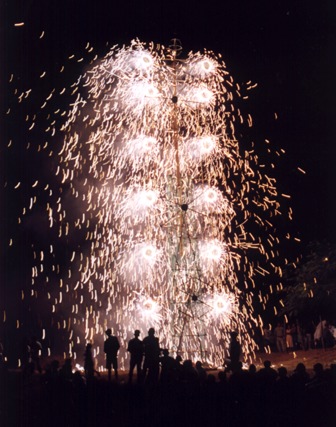 The great thing about the holiday season in Puerto Escondido is that, while the festive spirit is in
full force -- as the content of this issue will attest -- the Christmas commercial frenzy is kept in
check.
The great thing about the holiday season in Puerto Escondido is that, while the festive spirit is in
full force -- as the content of this issue will attest -- the Christmas commercial frenzy is kept in
check.
Here on the Oaxacan coast, there just isn't time to spend a month on shopping and jingles. December begins with the celebration of the Virgin of Juquila, a deeply-rooted cult that has made the nearby sanctuary Oaxaca's equivalent of Lourdes.
Then it's time to honor the Virgin of Guadalupe, Mexico's patron saint.
And once that's out of the way, there's the annual party to celebrate the patron saint of Puerto Escondido (and of the city of Oaxaca), The Virgin of Soledad. Only then is time for the special traditions of a Mexican Xmas.
So enjoy this perfect time to be in this special corner of the world. El Sol de la Costa wishes you all peace, joy and healthy for the holidays and beyond.
Warren Sharpe
Editor, El Sol de la Costa
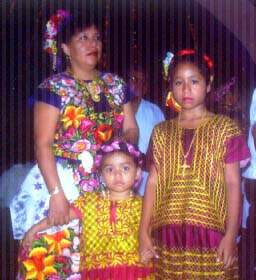 Sat 1 - Sun 2
Sat 1 - Sun 2
Istmeño residents of Puerto Escondido formed a cultural association here in 1996 to keep their traditions alive. Every December the group hosts a Vela Istmeña, an Isthmus-style fiesta devoted to Shunaaxhi (Zapotec for Virgin) Soledad, the patron saint of Puerto Escondido.
It begins with a calenda, the festive parade to announce the upcoming celebrations, scheduled to take place Nov. 29. On Nov. 30, the Parade of Floats, carrying the fiesta patrons dressed in the gorgeous costumes typical of the region pass through the main streets of town leaving from the market.
Sun 1 is the actual Vela Istmeña, the Crowning of the Fiesta Queen, and dancing to
the wee hours
10 p.m. Town Hall Esplanade
Sun 2 is the Washing of the Pots event, originating from the days before household conveniences,
when neighbors would accompany the mayordomos (patrons) to the river to help clean up after
the party. Today it serves as an excuse for further celebration among friends. No actual washing
takes place.
2 p.m. Salon Costa Alegre
Thu 6 - Sat 8
Fiesta of Our Lady of Juquila
Dec. 8 is the feast day for the Virgin of Juquila, whose sanctuaries nestle in the Chatino
region of the southern Sierra Madre Mountains in the town of Santa Catarina Juquila. It's about a
three hour drive from Puerto Escondido, a 30 Km detour off the highway to Oaxaca via Sola de Vega.
Juquila is Oaxaca's Lourdes, a place that attracts an estimated one million believers from all over Mexico each year, who make their pilgrimage to repay a blessing, to seek a cure for illness or to renew their faith.
The veneration of Our Lady of Juquila dates back to the early days of Christian evangelization in the 17th Century. The small statue of the Virgin is thought to be one of the first images carried through the area by Dominican missionaries, but legend has it that it just miraculously appeared one day in Amialtepec (another stop of the pilgrims' itinerary).
A wood and palm shrine was built for her there, but burned down. The image of the Virgin, however, was undamaged and moved to Juquila while the chapel was being rebuilt.
It is said that after the Virgin was taken back to its original site, it miraculously reappeared in Juquila, where it has remained for the intervening centuries, granting health to the sick, good fortune to the poor and love to the forlorn.
Images of the Virgin of Juquila can be seen in homes and businesses and in vehicles throughout the region and, during the course of the year, literally millions of believers make a pilgrimage to this mountain-top shrine. Many then stop here in Puerto Escondido to enjoy an outing by the sea after receiving blessings from this miraculous lady.
You will recognize their vehicles which are adorned with flowers and a framed image of the Virgin.
Puerto's Colonia Aeropuerto holds its Annual Fair during these days, a full-fledged traditional fiesta with the calenda and convite processions, rodeos, fireworks, dances, and sporting events, along with the more solemn religious rites to honor the Virgin of Juquila, the neighborhood's patron saint.
Hidalgo Tutupec, a community that lies just beyond Manialtepec Lagoon, also celebrates its annual saint's fair this week.
Mon 10 - Wed 12
Fiesta of Virgin of Guadalupe
Rockets and loud late-night parties attest to the popularity of Mexico's national patron saint
and "Empress of the Americas." Dec. 12 , the feast day for La Guadalupana is a national holiday;
banks, government offices and some businesses will be closed. Although it falls midweek, many
people take a long holiday weekend. And there will be lots of activities taking place, such as
rodeos, dances and carnivals to amuse them. (Details of which were unavailable at press time)
Puerto's Colonia Arroyo Seco and Las Negras (see festival program below), one of the villages on Manialtepec Lagoon, are among the local communities which hold full fiestas to honor Guadalupe as their patron saint during these days.
 Wed 12
Wed 12
Children's Procession
Don't miss this Guadalupe day Mexican tradition: Dressed in beautiful native costumes as indios
and inditas, the local kids parade through town to the church for a special mass.
5 p.m.
(See Below for more on the Virgin of Guadalupe)
Annual Fair Las Negras
Manialtepec Lagoon
Sun 9
9 a.m. Men's Volley Ball
9 p.m. Coronation of Fiesta Queen
Mon 10
9 a.m. Women's Volley Ball
9 p.m. Calenda, a brass band and huge puppets lead this festive
parade through the village streets
Tue 11
9 a.m. Soccer Tournament
8 p.m. Castillo, fireworks display
Wed 12
5 a.m. Mañanitas, serenade to the Virgin followed by dawn
mass
10 a.m. Mass
11 a.m. Water Games on the Lagoon, including launch and dugout canoe races
9 p.m. Dance with live band
Fri 14
New Moon in Sagittarius at 2:48 p.m
Sat 15
Opening of 4th "Artists on Zicatela" Art Fair
(through Sunday 23)
Group show by locally based artists and artisans includes displays of
finished artwork as well as arts workshops and demonstrations of craft
techniques, music and dancing and special events.
The Fair runs through Sunday, Dec. 23.
4 p.m. on the grounds of the Hotel ArcoIris and its La Galera Restaurant, Zicatela
Sun 16 - Tue 18
Fiesta of Our Lady of Soledad
The annual celebration for Puerto Escondido's patron saint (also the patron of the city of
Oaxaca) culminates in a unique local custom: the Wagnerian ritual of taking the statue of the
Virgin out to sea, accompanied by the local fishing fleet crammed with the faithful.
(More on Soledad Below)
Sun 16
Calenda
Festive procession through the streets of Puerto, with huge papier mache dolls, faroles
(lanterns), flower-bedecked floats and the inevitable banda brass band. It's the traditional
inauguration of the festivities.
8:30 p.m.
Mon 17
Concert of traditional chilena banda music
11:30 p.m. The plaza in front of the church
Social-Cultural Program
Program unavailable at press time.
7 p.m.
Castillo
An amazing fireworks display built around a cane and bamboo tower, preceded by the anarchic
running of the Torritos ("little bulls"), models rigged with fireworks and crackers carried
by young men who race around the square in a haze of light and explosion.
10 p.m. Town Hall Esplanade
Tue 18
Mañanitas,
The serenade to the Virgin and dawn mass
5 a.m.
Procession to the Sea
The statue of the Virgin is carried through the streets of town to the beach for the ceremony
out to sea
4 p.m.
Social-Cultural Program and Popular Dance
Most likely a folkloric presentation, followed by music to boogie by.
7 p.m. Town Hall Esplanade
Fri 21
Winter Begins at 1:21 p.m.
Sat 22
Grand Night of Disco
Organized by the church and the December Fiesta Committee, it will take place at either the Town
Hall Esplanade or the Benito Juárez Sports Stadium.
Sun 23

Jaripeo Rodeo
These festive bull-riding contests are enormously popular on the coast. This one is a benefit
for the town church. They generally begin around 4 p.m. (The rodeos normally take place on a site
opposite the ice plant on the highway, but a new rodeo arena was in the process of construction, at
this writing, on the way out of town towards San Pedro Mixtepec.)
Mon 24
Noche Buena
"The Good Night", Xmas Eve, is when Christmas is traditionally celebrated in Mexico with
families coming together for their Christmas feast and perhaps later attending the Misa del
Gallo, Midnight Mass. Many restaurants and hotels (including several of those whose
announcements in these pages make your free copy of El Sol possible) offer special menus
and dinner dances.
Mon 24 - Sun 25
Annual Fiesta in Barra de Navidad
Town is named for the season. Just east of Puerto, past the Colotepec River bridge.
Tue 25
Merry Christmas
An unusually quiet day in Mexico. If you are anxious for a traditional Xmas dinner, Art &
Harry's offers turkey and fixings.
The International Friends of Puerto Escondido, meanwhile, are hosting an "Evening of Holiday
Cheer" at Kep's Joy (250 pesos per person, limited capacity call 582-1673 for more information)
Fri 28
The Innocent Children
Los Niños Inocentes commemorates Herod's order to kill all new-born boys in an
attempt to kill the baby Jesus. It has become México's equivalent of April Fools' Day, when
people play tricks and practical jokes on each other. Is it not the fate of innocents in this world
to be made fools of?
Sun 30
Full Moon in Cancer at 4.42 a.m.
Mon 31
New Year's Eve
Look for special menus, live entertainment and dances at most of the major restaurants, clubs
and hotels.
Radio, Radio
Sunday 8 p.m. to 10 p.m.
Chiles y Chocolates, a bilingual radio
program hosted by "Lucy Sonido", actually Canadian musicologist Helena Szutska, an eclectic mix of
music from around the world.
Wednesday 9 p.m.
La Luciernaga (Firefly)
Lucy's midweek, commercial-free hour of free-flowing music. Radio Esmeralda,
94.1 FM.
 In December of 1531, according to legend, the Virgin appeared on several occasions to the Indian
Juan Diego, asking that a shrine be built for her. The church authorities ignored his supplications
until, on her last apparition, she left an image of a young, dark-skinned woman with Indian or
Mestiza (mixed race) features on his tilma, or cloak.
In December of 1531, according to legend, the Virgin appeared on several occasions to the Indian
Juan Diego, asking that a shrine be built for her. The church authorities ignored his supplications
until, on her last apparition, she left an image of a young, dark-skinned woman with Indian or
Mestiza (mixed race) features on his tilma, or cloak.
It is probably not mere coincidence that these visitations occurred on the hill of Tepeyac, site of one of the most important prehispanic religious centers in central Mexico.
The temple on the hill at Tepeyac (today the actual site of the Basilica of Guadalupe where the image that is housed) was dedicated to the worship of Tonantzin, "Our Mother". The religious authorities tried in vain to eradicate this tenacious cult, and perhaps decided instead to Christianize it in the form of Guadalupe.
The image of the Virgin of Guadalupe is one of the great mysteries of the world. This rough handmade garment has lasted over 460 years. The normal lifespan for the fabric made from agave would be from 10-20 years.
In their non-literate colonial society, the Indians read the symbolism of the image. They saw that this woman was greater than the moon she stood on, but that she was lesser than and coming from the Sun god. Her blue green outer cloak told them that she was his ambassador.
The stars on her cloak formed the constellations as they appeared in the sky on December 12, 1531. At her waist was a black sash, as was worn by all pregnant women at that time.
Most important of all, unlike the paintings and the statues in the churches, this messenger from God had skin the color of their own, a coppery brown.
 The Indians embraced Guadalupe as the protector of the Indian and Mestizo masses under the harsh
conditions of colonial rule.
The Indians embraced Guadalupe as the protector of the Indian and Mestizo masses under the harsh
conditions of colonial rule.
Over the centuries she emerged as an important symbol of Mexican national unity. It was the banner of La Guadalupana that Father Miguel Hidalgo chose to rally support for his struggle for independence from Spain in 1810.
Moving slowly through the maze of the Catholic ecclesiastical bureaucracy is a proposal to grant sainthood to Juan Diego.
His role as protector of the indigenous peoples of the continent is one that is still recognized today and symbolized by the delightful procession of children that takes place every year on December 12.
Dressed in beautiful native costumes, the little girls bedecked in ribbons and flowers, the boys in
white campesino dress, sombreros and carbon-daubed mustaches, the procession passes along Avenida
Oaxaca from the Parque El Idilio square at about 5 p.m. to the church for a special mass blessing
the children. Don't miss it.
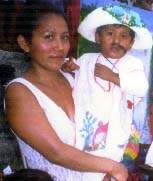 |
 |
 |
 The Virgin of La Soledad (Solitude) is the patron saint of both the city of Oaxaca and of Puerto
Escondido. The legend of Soledad originates in the 17th century, when the city of Oaxaca was on the
main trade route between Veracruz and the Pacific coast.
The Virgin of La Soledad (Solitude) is the patron saint of both the city of Oaxaca and of Puerto
Escondido. The legend of Soledad originates in the 17th century, when the city of Oaxaca was on the
main trade route between Veracruz and the Pacific coast.
According to this legend, a mule driver en route to Guatemala was surprised to find an extra mule bearing a strange wooden chest among his animals.
As he arrived at the monastery of Saint Sebastian the mule fell and resisted all efforts to get it on its feet.
Authorities were sent for and the mysterious box was opened, emitting a strong smell of gardenias. Inside was an image of the Virgin and a wooden icon of Christ.
A miracle was proclaimed and a temple dedicated to the Virgin of Soledad was erected at the site of the mule's demise.
(You can visit the newly-restored Basilica of Soledad and its adjoining museum in the city of Oaxaca on Avenida Independencia).
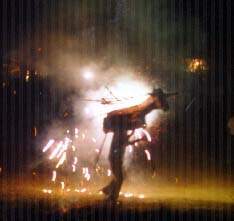 Puerto celebrates its patrona in three days of traditional festivities including religious
observances, processions (including the calenda on Dec 16), fireworks and dances.
Puerto celebrates its patrona in three days of traditional festivities including religious
observances, processions (including the calenda on Dec 16), fireworks and dances.
The fireworks display is known as a castillo, "castle," but actually it's a tower built of cane and bamboo and affixed with rockets and spinning wheels to create a fabulous show of choreographed pyrotechnic magic.
Before the castillo is lit, los toritos ("little bulls") run amok. Young men place these structures, -- most commonly in the form of a bull -- on their head and run around chasing the observers in a terrifying blaze of spinning lights and loud explosions.
The castillo always is held on the verbena, or evening before the feast day, in this case Dec. 17.
But the unique observance here takes place on Dec. 18, with the Salida al Mar, the trip out to sea. This acknowledges the importance of the ocean and fishing to the town.
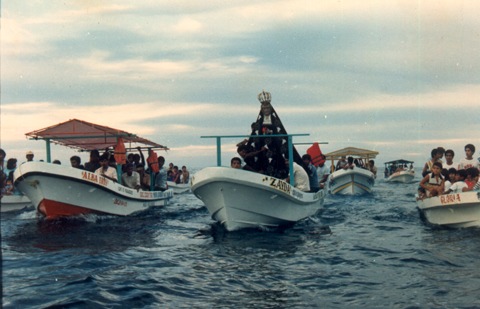 At about 4 p.m., the statue of La Soledad is taken from its niche in the church and, led by a brass
band and folkloric groups it is carried through the streets of town followed by throngs of
parishioners.
At about 4 p.m., the statue of La Soledad is taken from its niche in the church and, led by a brass
band and folkloric groups it is carried through the streets of town followed by throngs of
parishioners.
She is led down to the beach were she is placed in a fishing boat and, along with the band and as many of the faithful who can crowd into the available fishing launches, the Virgin is taken out to sea to the accompaniment of music, singing and the explosion of rockets.
The water caravan stays out for about an hour and a half and then La Soledad is carried back to the church which is named for her. The day concludes with a free dance at the Town Hall Esplanade.
Mexico's traditional Christmas festivities get underway on Dec. 16 with the eight days of Las Posadas (literally "the Inns", but in this sense the meaning is one of shelter or hospitality). These neighborhood parties represent Mary and Joseph's search for shelter before the holy birth.
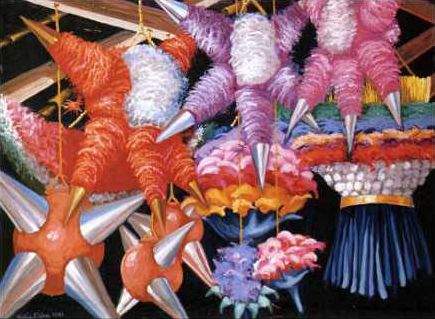 They begin with a candle-lit procession led by a couple dressed as the holy duo. Singing the
traditional Posada hymn, the participants stop at two homes in the neighborhood and ask for shelter,
but are turned away. The third stop is the location of the Posada, where the couple are warmly
admitted.
They begin with a candle-lit procession led by a couple dressed as the holy duo. Singing the
traditional Posada hymn, the participants stop at two homes in the neighborhood and ask for shelter,
but are turned away. The third stop is the location of the Posada, where the couple are warmly
admitted.
Most important to the Christmas celebration is Noche Buena, ("Good Night"), Christmas Eve. This is when families traditionally gather for their Christmas feast and perhaps later attend the Misa del Gallo, midnight mass.
Besides tamales, an essential for any Oaxacan celebration. Other traditional seasonal dishes include bacalao (dried fish), bunuelos (sweet fritters), the delicious hominy soup known as pozole, atole (a corn gruel drink), horchata (the same made with rice), fruit punches (ponches) and a kind of rice pudding known as Arroz a la Mexicana.
Christmas Day (Navidad) is an unearthly quiet Mexican day, as the families sleep and recover after all-night festivities. The traditional day for gift giving is Epiphany or Day of the Kings on January 6.
The serious symbolism of this simple party toy is very typical of Mexico as there is always more to understand than appears on the surface. The decorated clay pot represents Satan who often wears an attractive mask to hide his true nature. The most traditional style of Piñata is a star with seven points, each with streamers. These cones represent the seven deadly sins, and the breaking of the Piñata with the ensuing shower of sweets and fruits and nuts vividly shows the triumph of good over evil and the unknown joys and rewards which will be given in heaven to the good and faithful.

The plant was the obsession of Dr. Joel Poinsett, the first ambassador of the United States to Mexico.
The ancients, who considered all flowers to be divine gifts of the Gods, knew this plant as Cuetlaxochitl, which means "the flower of leather petals". This star-shaped, red, winter-flowering plant was a special favorite long before the arrival of Columbus.
The Nochebuena was considered by the Aztecs to be a symbol of the new life earned by the warriors who died in battle . As hummingbirds and butterflies, they returned to earth to sip the nectar of the Poinsettia.
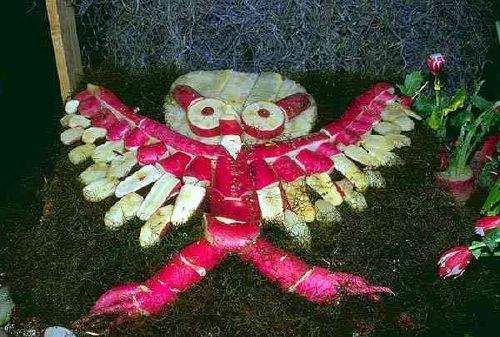 The Night of Radishes is a Christmas tradition unique to the City of Oaxaca. It's a popular
festival in which horticulturists and florists exhibit special designs created with huge radishes
(some weighing up to several kilos).
The Night of Radishes is a Christmas tradition unique to the City of Oaxaca. It's a popular
festival in which horticulturists and florists exhibit special designs created with huge radishes
(some weighing up to several kilos).
It lasts only a few hours, but it congregates thousands of locals, national and foreign visitors in the area around the Zócalo (Main Square) to enjoy yet another facet of the creativity of the Oaxaqueños who participate in this annual contest held on the 23rd of December.
The first vegetable gardens in Oaxaca were tended by Mixtec and Zapotec indigenous people on lands near to the La Noria and Cinco Señores Haciendas (Plantations) that were granted to them through a decree by Viceroy Luis de Velasco in 1563 and which later formed the town of Trinidad de las Huertas.
In those days, the market was held on the mustering grounds, which is now the Zócalo. Aside from the dried salted fish (bacalao), which forms one of the required dishes for Christmas dinner and was sold by vendors at the market place, the farmers of Trinidad de las Huertas sold their vegetables to round out the holiday menu. To make their stands more attractive and sell more produce, the vendors started to make figurines from the radishes, decorating them with cauliflower leaves and tender onions cut into flower shapes. They arranged their radishes, turnips, onions, lettuces and flowers artistically to attract the attention of the buyers. This practice became rooted to the point where homemakers began to look for these figures to decorate their Christmas tables. And on December 23, 1897, Don Francisco Vasconcelos Flores, then Mayor of the City, organized the first exhibit of these charming creations.
Some time ago, two more categories were added, that of Flor Inmortal (Straw Flowers) and Totomoxtle (Corn Husks) The Straw Flower is a dried flower that keeps its color and is used to make figurines and decorations, the dried corn husks are also used to create different images and representations.
The scenes created by the growers and artisans are inspired by Christmas motifs such as the Nativity, the Three Kings and by traditional Oaxacan festivals such as the Virgin of the Soledad, Day of the Dead, or by whatever their imagination dictates. Nowadays, the contest is organized by the Municipality of Oaxaca de Juárez, every category is assigned three cash prizes, and all of the participants receive a diploma as recognition for their efforts.
 The judges start their tour of the exhibits around 5 p.m. to select the winners. This is a
difficult decision because creativity and beauty are manifest in all their diversity and there are
many who deserve to win. Before presenting the awards, the Governor of the State, the Mayor of the
City, other dignitaries and special guests also tour the stands, admiring, asking questions and
congratulating the participants.
The judges start their tour of the exhibits around 5 p.m. to select the winners. This is a
difficult decision because creativity and beauty are manifest in all their diversity and there are
many who deserve to win. Before presenting the awards, the Governor of the State, the Mayor of the
City, other dignitaries and special guests also tour the stands, admiring, asking questions and
congratulating the participants.
After the presentation of the awards, all of those present patiently wait for the traditional fireworks that end all festivities here in the City and the state of Oaxaca.
This is a unique festival of artistic creativity in which an ambiance of conviviality reigns as in no other. It's not only worth going to, it's also not to be missed if one wants to feel the joy and human warmth and the true Christmas spirit of the people of Oaxaca.


Puerto Escondido surfers dominated the tournament, taking six of the eight winning places. Raúl Noyole and Heribero Ramirez repeated the fierce duel that marked last year's competition. Rising star David Rutherford took fourth place. His brother, José, took top honors in the Body Board event Open:
 Boogieboard:
Boogieboard: